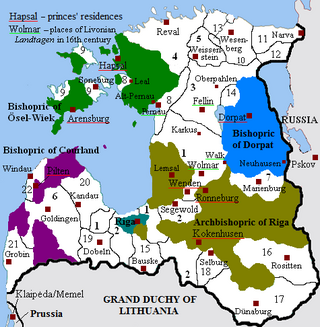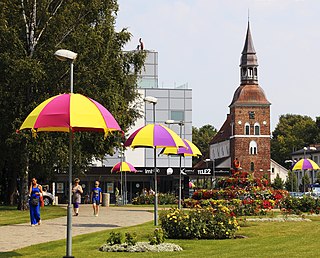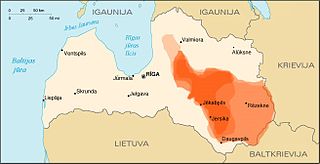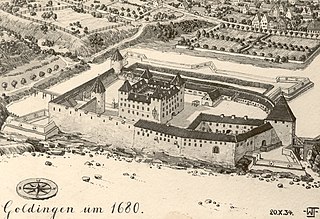
Livonia or in earlier records Livland, is a historical region on the eastern shores of the Baltic Sea. It is named after the Livonians, who lived on the shores of present-day Latvia.

The Northern Crusades or Baltic Crusades were Christianization campaigns undertaken by Catholic Christian military orders and kingdoms, primarily against the pagan Baltic, Finnic and West Slavic peoples around the southern and eastern shores of the Baltic Sea.

Valmiera is the largest city of the historical Vidzeme region, Latvia, with a total area of 19.35 square kilometres. As of 2002, Valmiera had a population of 27,323, and in 2020, it was at 24,879. It is a state city, and is the seat of the Valmiera Municipality. Valmiera is one of the oldest cities in Latvia; it was a member of the Hanseatic League. According to the ethnic composition, Valmiera has the largest proportion of ethnic Latvians among the state cities.

Swedish Livonia was a dominion of the Swedish Empire from 1629 until 1721. The territory, which constituted the southern part of modern Estonia and the northern part of modern Latvia, represented the conquest of the major part of the Polish-Lithuanian Duchy of Livonia during the 1600–1629 Polish-Swedish War. Parts of Livonia and the city of Riga were under Swedish control as early as 1621 and the situation was formalized in the Truce of Altmark 1629, but the whole territory was not ceded formally until the Treaty of Oliva in 1660. The minority part of the Wenden Voivodeship retained by the Polish–Lithuanian Commonwealth was renamed the Inflanty Voivodeship, which today corresponds to the Latgale region of Latvia.

The Livonian Order was an autonomous branch of the Teutonic Order, formed in 1237. From 1435 to 1561 it was a member of the Livonian Confederation.

Koknese is a town in Aizkraukle Municipality in the Vidzeme region of Latvia, on the right bank of the Daugava River. It has a population of nearly 3,000.

Alūksne is a town on the shores of Lake Alūksne in northeastern Latvia near the borders with Estonia and Russia. It is the seat of the Alūksne municipality. Alūksne is the highest elevated Latvian city, located in East Vidzeme Upland at 217 m above sea level. The high elevation of the city affects the social and physical arrangement of the place.

Smiltene is a town in the Vidzeme region in northern Latvia, 132 km northeast of the capital Riga, and the administrative centre of Smiltene Municipality. It has a population of 5,536 (2015).

The Livonian crusade consists of the various military Christianisation campaigns in medieval Livonia – modern Latvia and Estonia – during the Papal-sanctioned Northern Crusades in the 12th–13th century. The Livonian crusade was conducted mostly by the Holy Roman Empire and the Kingdom of Denmark. It ended with the creation of Terra Mariana and the Danish duchy of Estonia. The lands on the eastern shores of the Baltic Sea were one of the last parts of Europe to be Christianised. The available information is largely based on Livonian Chronicle of Henry.

Mõtsa Pūol or Metsepole was a medieval Livonian county inhabited by the Finnic-speaking Livonians, situated on the east coast of the Gulf of Riga, in most part at the northwest of the Vidzeme region of what is now Latvia, and including some adjacent areas in the present-day Pärnu County of Estonia. Metsepole was bordered by the ancient Estonian Sakala County to the north, Latgalian Tālava to the east and Livonian county of Turaida to the south.

The Krimulda Castle is located just outside Sigulda, Sigulda Municipality in the Vidzeme region of Latvia and is a tourist attraction. The castle dates from the 14th century and was destroyed in a war in 1601. Prince Liven’s living house was built in the classic style. The manor complex consists of steward’s house, coach house, Swiss cottage, etc. Home wine tasting is available by prior arrangement.

The Principality of Jersika was a medieval Latgalian principality in the east of modern-day Latvia, and one of the largest medieval states in Latvia before the Northern Crusades. The capital of Jersika was located on a hill fort 165 kilometres (103 mi) southeast of Riga. In documents written in Latin from the 13th century, the Principality′s western part is called Lettia, and the eastern part in Old East Slavic called Lotigola.

Dzērbene Manor is a manor house in the historical region of Vidzeme, northern Latvia.

Tālava was a Latgalian country in the northern Vidzeme and northern Latgale region of modern-day Latvia. It was bordered by the Latgalian Principality of Jersika to the south, the Livonian counties of Metsepole and Idumeja to the west, the Estonian counties of Sakala and Ugandi to the north and the Russian Novgorod Republic to the east.

Dobele Castle is a castle in the town of Dobele in the historical region of Zemgale, Latvia. The Livonian order built the castle on the west bank of the Berze river in 1335, on the site of an old hillfort.

Lielvārde Castle is a castle in Lielvārde, a town in Ogre Municipality in the Vidzeme region of Latvia.The castle was built at the steep bank of Daugava River, overseeing this important medieval waterway, before 1248 by Albert of Buxthoeven, an archbishop of Riga. During the Livonian War, Lielvārde Castle was destroyed by Russian troops in 1579. Its ruins are conserved up to the level of the second floor.

Dinaburga Castle, also known as Vecdaugavpils or Vecpils, is a castle located in Naujene Parish, Augšdaugava Municipality in the Latgale region of Latvia, east of Daugavpils. It is strategically situated on a high bank of the Daugava River. It was built between 1273 and 1277 by the Livonian Order, and destroyed by Russian troops before 1577. Nowadays, fragments of the foundation are exposed.

Alūksne Castle is a castle of Teutonic Knights in current Alūksne, North-Eastern Latvia.

Kuldīga Castle also Goldingen Castle and Jesus Castle was a medieval castle of the Livonian Order in historical Courland in town Kuldīga near Venta Rapid. Today on the left bank of the Venta at the end of the old bridge one can find the former castle mill, a castle guard's house and a city park with the castle ruins on Rumba Hill.






















